A FOGGY MORNING (I'll tell you why it happens and one more story) - My street photography stories || ENG-ESP || (12 pics)
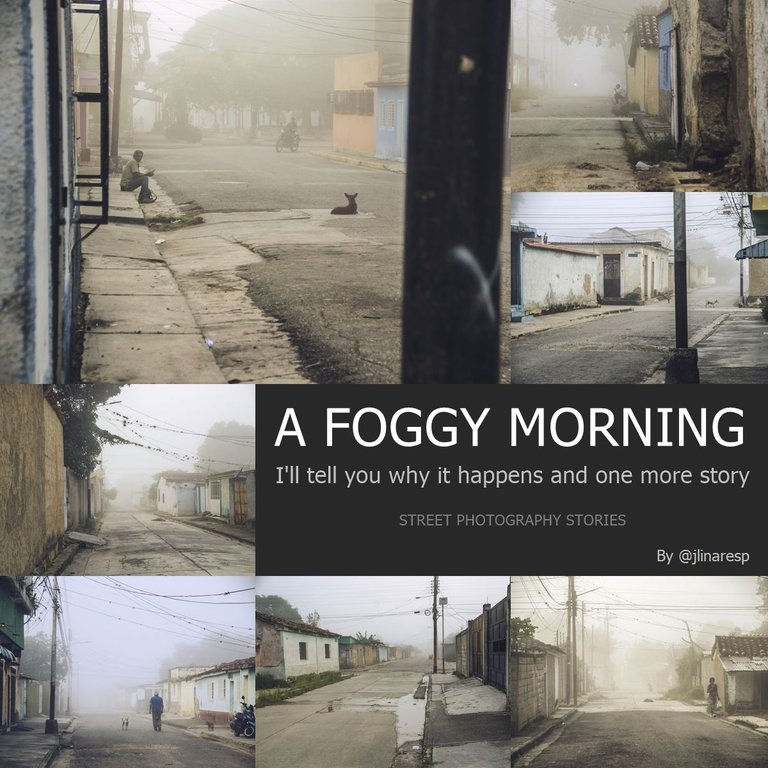
I estimate that in one out of three mornings a year in my town (Montalbán, Carabobo, Venezuela) I can wake up and peek my head through a shutter of my window and observe the streets shrouded in a large amount of fog. This is something frequent here and the inhabitants of the town grow up and live with the certainty that the morning fog is something very common here... In my case, foggy mornings are replete with anecdotes. And I am not only talking about my most recent years as a street photographer, but also about memories from my youth and stories I have heard about fog from my grandparents and my mother. And this is precisely what I want to talk to you about today, first I will tell you how I learned the reason for the high frequency of fog in the mornings of my town, because this happens all year long no matter if we are in the rainy or dry season. And the other story has more related to what I call “fables of the people” and is that kind of stories which speaks of past times and ancient beliefs...
Estimo que en una de cada tres mañanas al año en mi pueblo (Montalbán, Carabobo, Venezuela) puedo despertar y asomar mi cabeza a través de un postigo de mi ventana y observar las calles envueltas en gran cantidad de niebla. Esto es algo frecuente aquí y los habitantes del pueblo crecemos y vivimos con la certeza de que la neblina matutina aquí es algo muy común... En mi caso, las mañanas con nieblas están repletas de anécdotas. Y no hablo solo de mis años más recientes como fotógrafo callejero, si no que hablo también de recuerdos de mi juventud y de historias escuchadas por mi respecto a la niebla, de la boca de mis abuelos y mi madre. Y acerca de esto es precisamente que quiero hablarles hoy, primero les contaré como fue que aprendí el porqué de la frecuencia tan alta de presencia de neblina en las mañanas de mi pueblo, pues esto ocurre durante todo el año sin importar que el que estemos en temporada de lluvias o de sequía. Y la otra historia tiene que ver más con eso que yo llamo "fábulas del pueblo" y es de ese tipo de historias las cuales habla de tiempos pasados y creencias antañas...
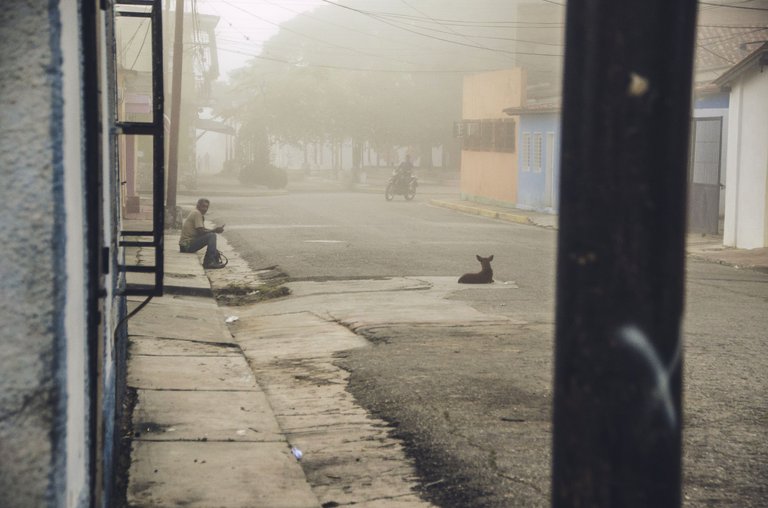
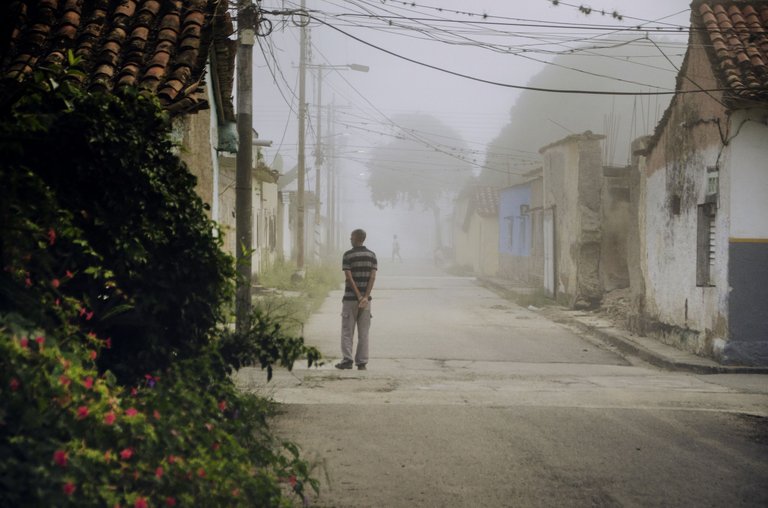
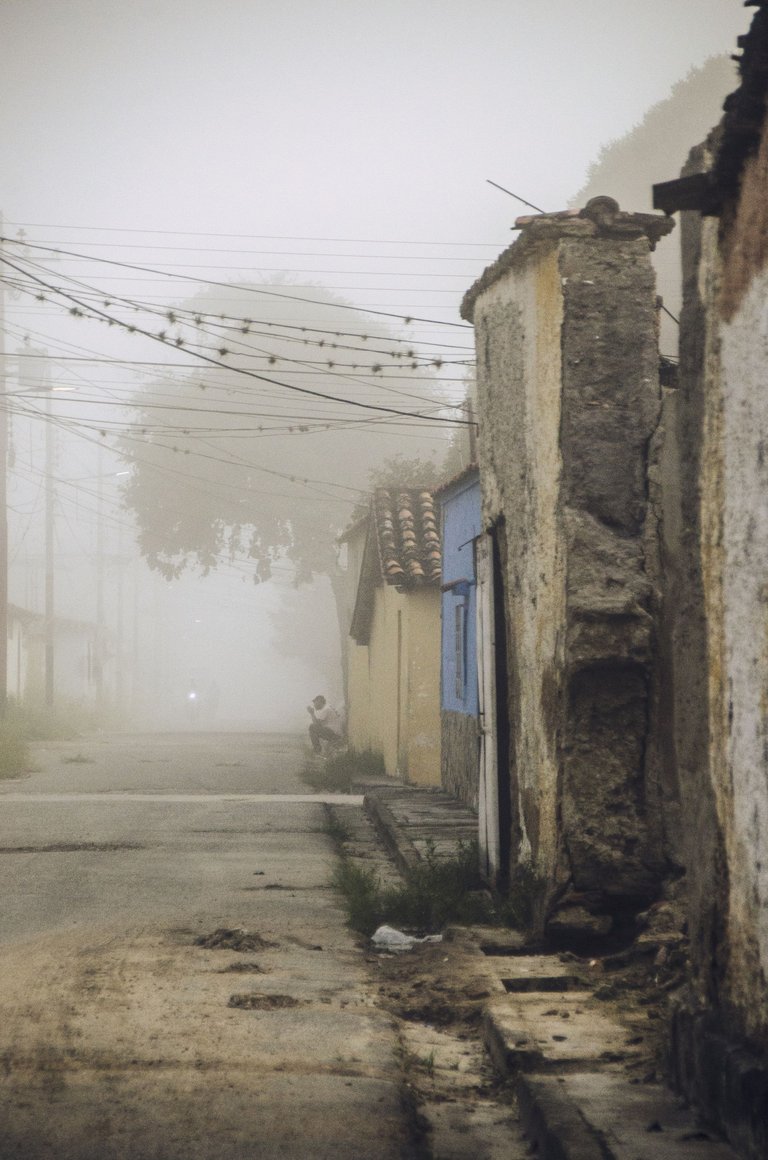
WHY IS IT SO FOGGY HERE?
¿POR QUÉ HAY TANTA NIEBLA AQUÍ?
I distinctly remember one morning when I was a 14 year old boy (about four decades ago) and a student in my penultimate year of high school, walking down the main street of the town at about 6:30 AM. I was on my way to attend classes at our public high school located on the eastern outskirts of town. The morning was so foggy that my eyebrows were dripping with dew that accumulated on them as I walked. After walking the more than 2 kilometers that separated my house from my place of study, I saw our geography teacher descending from a bus coming from Valencia (the capital of our province, located about 50 km to the East) and after greeting him with the respect that the case deserved, I said to him as we walked towards the entrance of the high school: Teacher, do you know by coincidence why in Montalbán we have so many mornings of very dense fog?... My teacher, whose name was “Edgar” indeed, lit up his eyes and smiled. Then he told me: “Caray Linares (he named all his students by last name), I am glad you asked that question and I have the answer because I observe it every day”...
Recuerdo perfectamente una mañana en la cual yo siendo un chico de unos 14 años de edad (unas cuatro décadas atrás) y cursante del penúltimo año de secundaria, recorría la calle principal del pueblo cerca de las 6:30 AM. Entonces me dirigía a asistir a mis clases en nuestro liceo público ubicado al Este de en las afueras del pueblo. La mañana era de una niebla tan densa que de mis cejas caían gotas del rocío que se acumulaba en ellas mientras caminaba. Después de recorrer los más de 2 kilómetros que me separaban mi casa de mi lugar de estudio, observé a nuestro profesor de geografía descendiendo de un autobús proveniente de Valencia (la capital de nuestra provincia, ubicada unos 50 Km al Este) y después de saludarlo con el respeto que ameritaba el caso, le dije mientras caminábamos rumbo a la entrada del liceo: ¿Profesor, sabrá usted por casualidad porqué en Montalbán tenemos tantas mañanas de niebla muy densa?... A mi profesor, que se llamaba "Edgar" por cierto, se le iluminaron los ojos y sonrió. Luego me dijo: "Caray Linares (nombraba a todos sus estudiantes por apllido), me agrada que hayas preguntado eso y te tengo la respuesta pues la observo a diario"...
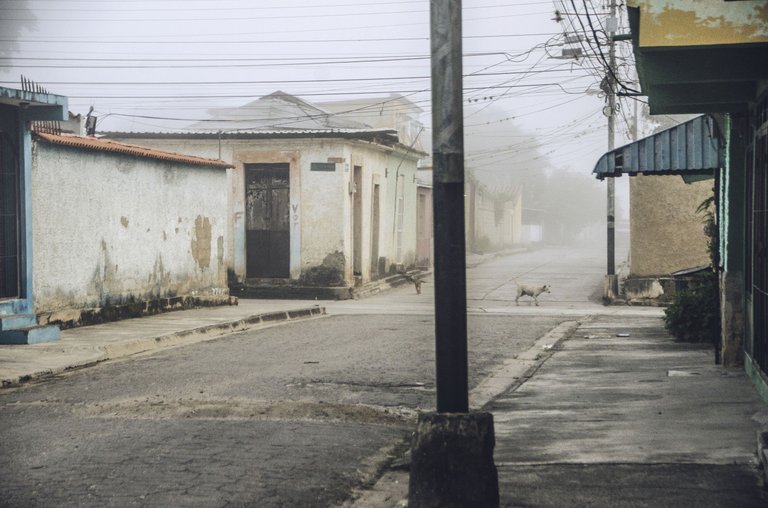
Professor Edgar answered my question more or less as I recall: The valley of Montalbán is nestled at the foot of a chain of mountains in the shape of a “horseshoe” which enclose it to the North, East and South, leaving the valley open in an easterly direction only. Then, in that direction (East) about 50 kilometers in a straight line is located the “Lake of Valencia” in whose depression are generated large masses of hot and humid air, which, when the wind blows in an East-West direction, are displaced in the direction of the valley of Montalbán. But along the way they encounter two small mountain ranges located practically between the lake and the town, this causes the displaced air masses to cool and gradually condense into clouds, which finally reach the Montalbán valley which, being higher (660 m.a.s.l.), receives them directly in the form of fog. This fog is “trapped” there by the higher mountain ranges that surround the valley (with peaks of up to 1,800 m.a.s.l.) and usually remains there until sunlight heats it and makes it rise or evaporates it. This does not always happen, as we do not always have East-West wind, but when we do, the phenomenon occurs.
EL profesor Edgar respondió mi pregunta más o menos así como recuerdo: El valle de Montalbán está enclavado al pie de una cadena de montañas en forma de "herradura" las cuales le encierran por el Norte, el Este y el Sur, dejando el valle abierto en dirección Este únicamente. Entones, en esa dirección (Este) a unos 50 kilómetros en línea recta está ubicado el "Lago de Valencia" en cuya depresión se generan grandes masas de aire caliente y húmedo, las cuales, cuando el viento sopla en dirección Este-Oeste, son desplazadas en dirección al valle de Montalbán. Pero a lo largo del trayecto se topan con dos pequeñas cordilleras ubicadas prácticamente entre el lago y el pueblo, esto hace que las masas de aire desplazadas se enfríen y se condesen gradualmente convirtiéndose en nubes, las cuales finalmente llegan al valle de Montalbán que por ser más alto (660 m.s.n.m) las recibe directamente en forma de niebla. Esta niebla queda "atrapada" allí por las cordilleras más altas que rodean el valle (con picos de hasta 1.800 m.s.n.m) y por lo general permanece hasta que la luz solar calienta y las hace ascender o las evapora. Esto no sucede siempre, pues no siempre tenemos viento Este-Oeste, pero cuando lo tenemos así ocurre el fenómeno.
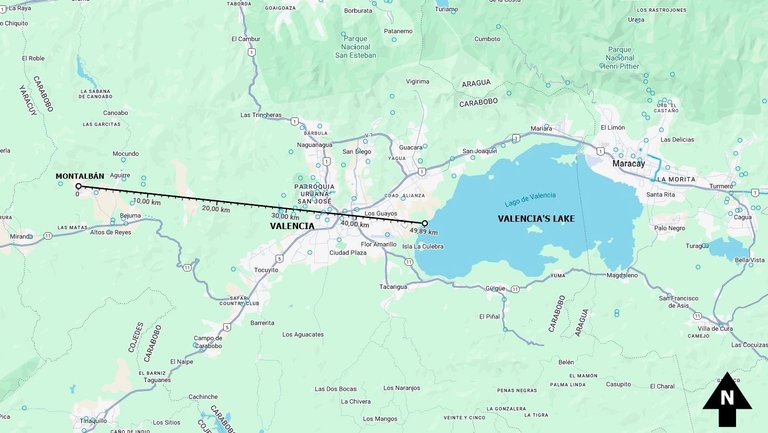
I have put a small map taken from Google Maps so that you can see how accurate was that answer from my professor Edgar... Obviously, at that time I was dumbfounded when I heard such a precise and correct clarification (keep in mind that it was 1985 and we had no internet or anything like that). The only thing I could do was to ask my professor the following question: Wow professor and how do you know all that? And my professor with an funny face looked me in the eyes and said: because I do exactly that same route of the air masses when I come on the bus every day! 😂... And that was very true, the road runs practically the same route as the bus that our teacher took to come to our village!... I think I spent about fifteen minutes laughing, but I also learned since then (and it stayed in my head forever) why we have so many mornings with dense fogs in this town.
He puesto un pequeño mapa tomado de Google Maps para que ustedes observen cuan acertada fue esa respuesta de mi profesor Edgar... Obviamente, en aquel entonces yo quedé boquiabierto escuchado semejante aclaratoria tan precisa y correcta (tomen en cuenta que era 1985 y que no teníamos internet ni nada parecido). Lo único que atiné a a hacer fue preguntar a mi profesor lo siguiente: Caray profesor y ¿Cómo sabe todo eso usted? Y mi profesor con cara divertida me miró a los ojos y dijo: !porque hago exactamente ese mismo trayecto de las masas de aire cuando vengo en autobús diariamente! 😂... ¡Y eso era muy cierto, la carretera recorre prácticamente la misma ruta que el autobús que tomaba nuestro profesor para venir a nuestro pueblo!... Creo que estuve unos quince minutos riendo, pero también aprendí desde entonces (y se quedó en mi cabeza para siempre) el por qué tenemos tantas mañanas con nieblas densas en este pueblo.
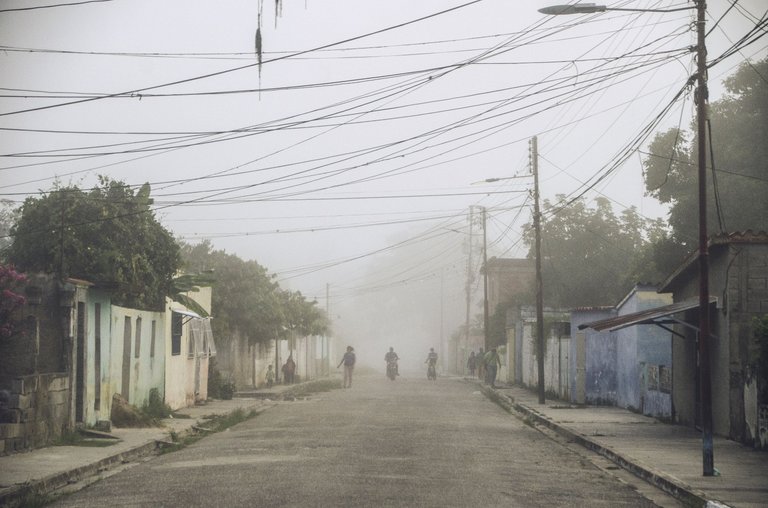
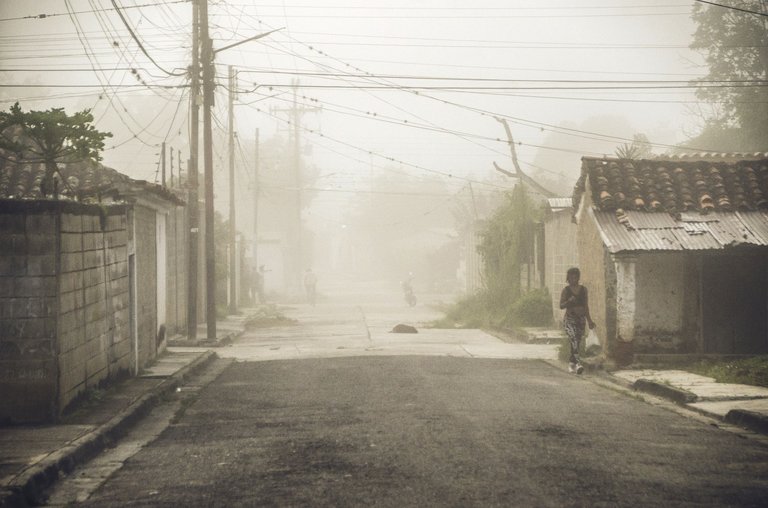
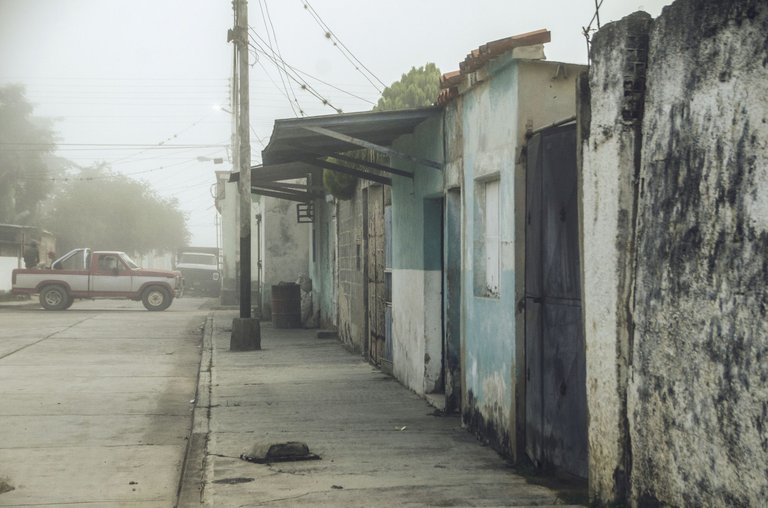
THE WITCH WHO VISITED MY GRANDMOTHER
LA BRUJA QUE VISITÓ A MI ABUELA
In Montalbán even today there are people who say that during the early mornings when the valley is filled with very dense fog, the witches that live in the mountains do their spells and fly over the houses of the town with not very good intentions (take into account that this is still a very rural town and therefore this type of belief is common in people, especially the very old ones)... The story I am about to tell you was told to me by my maternal grandmother (called “Olimpia” by the way) in 1978 while she was taking care of me because my mother was recovering from giving birth to my younger sister... My grandmother loved to “scare” her grandchildren using stories of witches, ghosts, demons and so on 😂 (something very typical in those times but unthinkable for a grandparent to do nowadays, it seems to me)... The truth is that my grandmother one night of that May '78 told me the story of “Come tomorrow for salt”...
En Montalbán aún hoy por hoy hay personas que dicen que durante las madrugadas cuando el valle se llena de niebla muy densa, las brujas que viven en las montañas hacen sus hechizos y salen a volar sobre las casas del pueblo con no muy buenas intenciones (tomen en cuenta que este es un pueblo muy rural aún y por lo tanto es común este tipo de creencias en personas, especialmente las muy mayores)... La historia que voy a contarles me la narró mi abuela materna (llamada "Olimpia" por cierto) en el año 1978 mientras ella cuidaba de mi por estar mi madre recuperándose de haber dado a luz a mi hermana menor... A mi abuela le encantaba "asustar" a sus nietos usando historias de brujas, espantos, demonios y demás 😂 (algo muy típico en aquellos tiempos pero impensable de hacer por un abuelo en la actualidad, me parece)... Lo cierto es que mi abuela una noche de aquel Mayo del 78 me contó la historia de "Ven mañana por sal"...
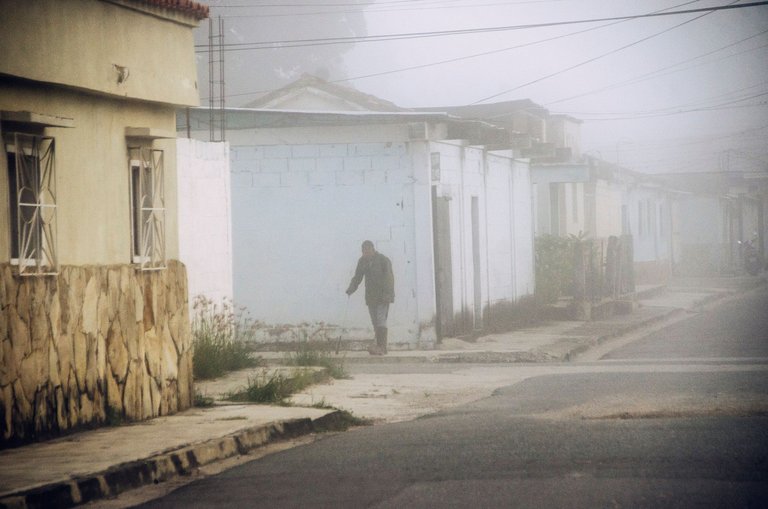
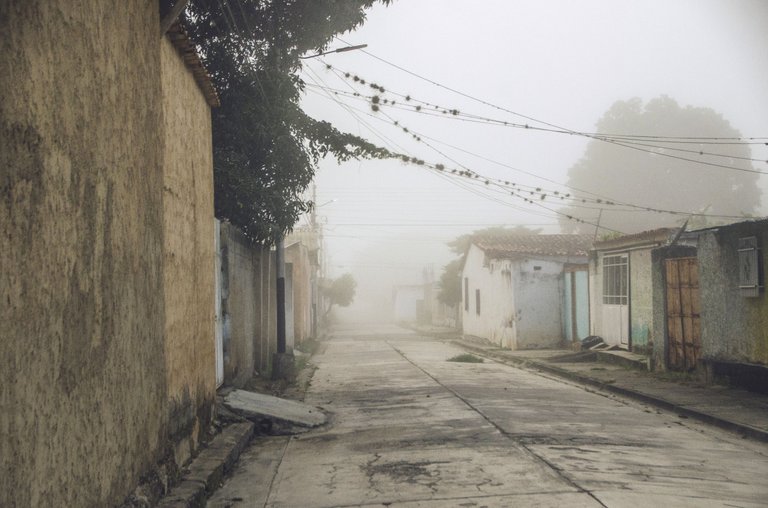
What my grandmother told me was the following: In the 50's of the last century (my grandmother never gave exact dates) having already born my mother (the youngest of three siblings) she was already awake and preparing the day's coffee at 3:30 AM. In those days it was very common to get up at that time of the morning to start preparing the corn to cook the corn dough cakes called by us “arepas”. This was a multi-step process and usually took a couple of hours or more to complete (there was no such thing as precooked flour or anything similar, everything was done using fresh corn shelled and manually milled)... The truth was that, that early morning full of fog, my grandmother heard over the kitchen roof where she was, a strong wind and a kind of strong flapping. My grandmother immediately remembered the stories about witches who flew over the village in the early misty mornings to avoid being seen. But she was still a very young woman who had little belief in such things and also possessed a frankly irritating sense of humor. Then my grandmother shouted in a very loud voice: “Come tomorrow for salt” and let out a laugh. My grandfather, who was cleaning the place where the mules were sleeping, told her: “Olimpia, shut your mouth, you don't play with those things”. But my grandmother defiantly continued laughing and did not give the matter any more importance.
Lo que mi abuela contó fue lo siguiente: En los años 50 del siglo pasado (mi abuela nunca daba fechas exactas) habiendo ya nacido mi madre (la menor de tres hermanos) ella se encontraba ya despierta y preparando el café del día a las 3:30 AM. En aquellos días era muy común levantarse a esas horas de la madrugada para comenzar a preparar el maíz y así proceder a cocinar las tortas de masa maíz llamadas por nosotros "arepas". Este era un proceso de varios pasos y usualmente ocupaba un par de horas o más realizarlos (no existían las harinas precocidad ni nada similar, todo se hacía usando maíz fresco desconchado y molido manualmente)... Lo cierto fue que, aquella madrugada repleta de niebla por cierto, mi abuela escuchó sobre el tejado de cocina donde ella se encontraba, un fuerte viento y una especie de aleteo fuerte. Mi abuela enseguida recordó las historias sobre brujas que volaban sobre el pueblo en las madrugadas con niebla para no ser vistas. Pero ella era una mujer aún muy joven que poco creía en esas cosas y además poseía un sentido del humor francamente irritante. Entonces mi abuela gritó en voz muy alta: "Ven mañana por sal" y dejo escapar una carcajada. Mi abuelo, que se encontraba limpiando el lugar donde pernoctaban las mulas, le dijo: "Olimpia, cállese la boca, que con esas cosas no se juega". Pero mi abuela desafiante, continuó riendo y no le dio mayor importancia al asunto.
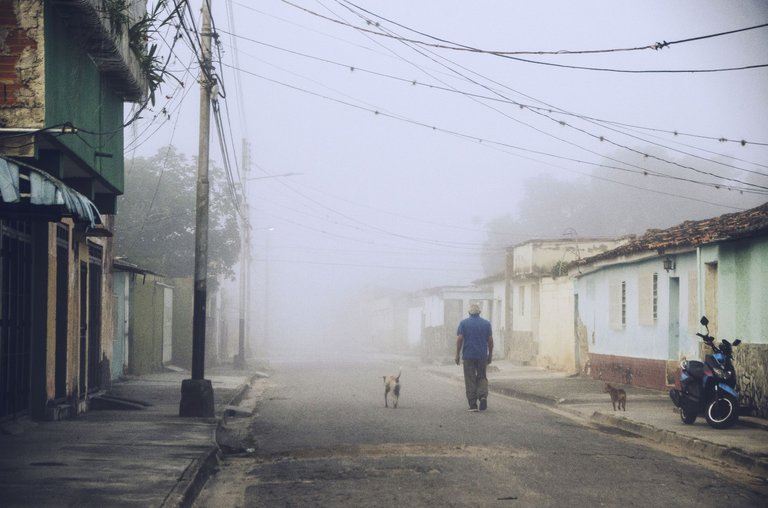
“Come tomorrow for salt” is a phrase which, it has always been said, people used to “bring a witch down and ask her to do something in exchange for a jar of salt”. And my grandmother had heard that phrase from her elders and that early morning she used it as a joke about the whole thing. But the truth was that, almost at dawn the next day, when my grandmother was about to finish preparing breakfast (around 5:30 AM according to her) and my grandfather was ready to have breakfast and then go on muleback to the fields to work his crops, a loud and repetitive “knock-knock” was heard. A loud and repetitive “knock-knock” echoed over the wide wooden gate of the backyard, the same one through which my grandfather used to go out with his mules and horses. At the same time an intense smell of putrid and scorching flesh filled the whole atmosphere and then my grandfather, who was a somewhat strange but very knowledgeable man (he healed animals and people from snake bites by praying, there were also those who said they saw him in more than one place at the same time and he was always muttering Our Fathers and Hail Marys) immediately guessed what was happening and shouted out: “Olimpia, get inside the house and don't come out, and have the salt pot ready because I need it”... My grandmother, already a little frightened, obeyed but only half-heartedly, and kept looking through the cracks of a window that faced the door where the knocking was heard... My grandmother said that, my grandfather crossed himself a couple of times and prayed something in a very low voice, then he opened the door and there in front of him was a very tall woman (my grandfather was 5'10" but barely reached the chin height of that strange woman according to my grandmother's narration)... The strange woman was covered in rags and from her torn sleeves, according to my grandmother, dark excrescences and some vermin like centipedes and worms were oozing out of her sleeves. My grandfather, with surprising aplomb and almost without flinching, said to her: “Good morning Adelia, what can I do for you?” and the horrible woman answered: “Marcos (my grandfather's name) tell Olimpia that I came for the salt and to tell me what she needs in exchange”... The woman handed my grandfather a dirty and blackened bowl that seemed to be made of some kind of clay according to my grandmother. Then my grandfather entered with the bowl and filled it with salt, but not before saying to my grandmother (who was now totally terrified) “Keep on bringing witches down, Olimpia, that one day when I am not here, you might lose your soul” and left the house with the salt, he faced the woman again and said: “Here is the salt Adelia, and Olimpia says that she will not need anything for the moment”... Then the woman shook her head as if nodding and turned to leave...
"Ven mañana por sal" es una frase la cual, según se ha dicho siempre, las personas usaban para "hacer descender a una bruja y pedirle que hiciera algo a cambio de un tarro de sal". Y mi abuela había escuchado esa frase sus mayores y esa madrugada la usó como para hacer un chiste de todo aquello. Pero lo cierto fue qué, casi al amanecer de día siguiente, estando mi abuela ya casi por terminar de prepara el desayuno (cerca de las 5:30 AM según decía ella) y mi abuelo presto a desayunar para luego ir a lomos de mula rumbo al campo a trabajar sus cultivos. Un fuerte y repetitivo "toc-toc" retumbó sobre la amplia puerta de madera del patio trasero, la misma por donde salía mi abuelo con sus mulas y caballos. Al mismo tiempo un intenso olor a carne pútrida y chamusquina llenó el ambiente por completo y entonces mi abuelo, quien era un hombre un poco extraño pero muy conocedor de las cosas (sanaba de mordeduras de serpiente a animales y personas rezando, también hubo quienes decían que lo veían en más de un lugar a un mismo tiempo y siempre estaba murmurando padrenuestros y avemarías) enseguida supuso lo que estaba sucediendo y gritó: "Olimpia, métase dentro de la casa y no salga, y tenga listo el pote de la sal porque la necesito"... Mi abuela, ya un poco asustada obedeció pero a medias, y se mantuvo mirando a través de las rendijas de una ventana que daba hacia la puerta donde se escucharon los golpes... Contaba mi abuela que: Mi abuelo se santiguó un par de veces y rezó algo en voz muy baja, entonces abrió la puerta y allí frente a él estaba una mujer muy alta (mi abuelo era de 1.70 mts pero apenas alcanzaba la altura de mentón de aquella mujer extraña según narraba mi abuela)... La extraña mujer estaba cubierta con harapos y de las mangas rotas, según contaba mi abuela, la manaban excresencias obscuras y algunas alimañas como ciempiés y gusanos. Mi abuelo, con un sorprendente aplomo y casi sin inmutarse le dijo: Buenos días Adelia ¿En que puedo servirte? y la horrible mujer contestó: "Marcos (así se llamaba mi abuelo) dígale a Olimpia que vine por la sal y que me diga qué cosa necesita a cambio"... La mujer le entregó a mi abuelo un cuenco sucio y ennegrecido que parecía hecho de algún tipo de arcilla según contaba mi abuela. Entonces mi abuelo entró con el cuenco y lo llenó de sal no sin antes decirle a mi abuela (que se encontraba, ahora sí, totalmente aterrada) "Sigue bajando brujas Olimpia, que un día que yo no esté capaz y pierdes el alma" y salió de la casa con la sal, se enfrentó de nuevo a la mujer y le dijo: Aquí está la sal Adelia, y dice Olimpia que ella no va a necesitar nada por los momentos... Entonces aquella mujer movió la cabeza como asintiendo y se dio la vuelta para marcharse...
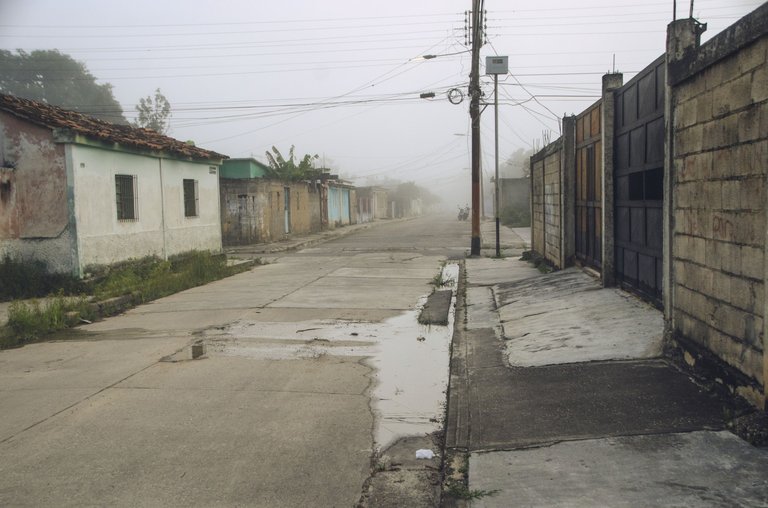
My grandmother said that that morning, after closing the wooden door where the “witch” knocked, my grandfather entered the house again as if nothing important had happened. My grandmother did not dare to ask my grandfather anything about it either, and since then she had a certain kind of respect for him similar to that of some neighbors in town who said that my grandfather “talked to the dead and saw things of the future”. And that matter of “The witch who visited my grandmother” was only talked about again after the death of grandfather Marcos...
Contó mi abuela que aquella mañana, después de cerrar la puerta de madera en donde tocó la "bruja", mi abuelo entró a la casa nuevamente como si no hubiese sucedido nada importante. Mi abuela tampoco se atrevió a preguntarle a mi abuelo nada al respecto y desde entonces le tuvo un cierto tipo de respeto similar a el que le profesaban algunos vecinos del pueblo quienes decían que mi abuelo "hablaba con muertos y veía cosas del futuro". Y de aquel asunto de la "La bruja que visitó a mi abuela" solo se volvió a hablar una vez fallecido el abuelo Marcos...
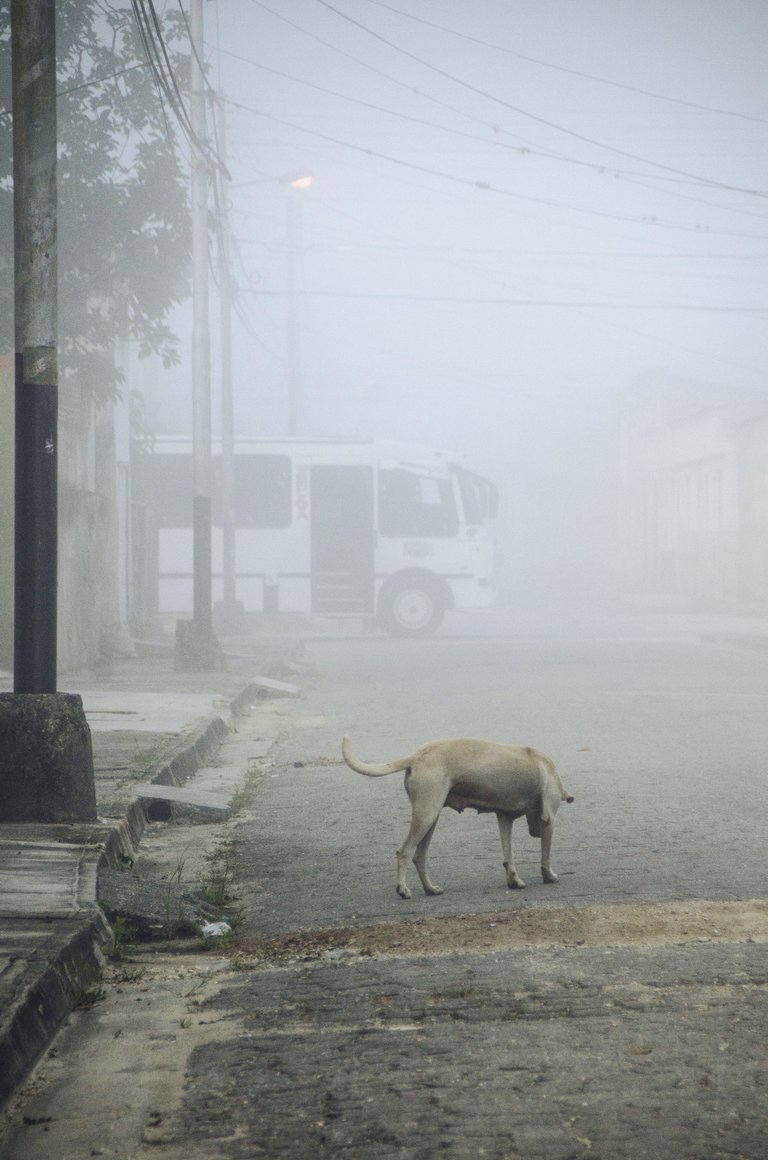
I hope you all liked this couple of stories, I have hundreds of anecdotes and stories about my town to tell and share, I hope I can do it gradually here in #Hive.... The accompanying photos in this post were taken by me on a recent foggy morning. So foggy that at some points it was even difficult to focus.... But that's how it often dawns here and it's impossible for me not to go out and take pictures when it happens! 🤓📷
Espero que este par de historias les hayan gustado a todos, tengo cientos de anécdotas e historias de mi pueblo para contar y compartir, espero poder hacerlo gradualmente aquí en #Hive... Las fotos que acompañan en esta publicación, fuero tomadas por mi en una reciente mañana repleta de niebla. Tan repleta de niebla qué en algunos momentos inclusos era difícil enfocar... ¡Pero así es como amanece con frecuencia aquí y es imposible para mi no salir a hacer fotos cuando sucede! 🤓📷
Thank you very much for your visit and appreciation!
¡Muchas gracias por pasar y apreciar!
ADDITIONAL TECHNICAL NOTE: Photographs captured with my Nikon D7000 DSLR camera in RAW format, then processed in Adobe Camera RAW for adjustments regarding light, sharpening, contrast and depth... They were then exported to JGP format on which minor modifications such as straightening and adding watermarks were carried out using PhotoScape v3.7
NOTA TÉCNICA ADICIONAL: Fotografias capturadas con mi cámara DSLR Nikon D7000 en formato RAW, procesadas posteriormente en Adobe Camera RAW para ajustes relativos a luz, afilado, contraste y profundidad... Luego fueron exportadas a formato JGP sobre el cual se llevaron a cabo modificaciones menores como enderezado y agregado de marcas de agua usando PhotoScape v3.7
"We make photographs to understand what our lives mean to ourselves." - Ralph Hattersley.
"Hacemos fotografías para comprender lo que nuestras vidas significan para nosotros mismos." - Ralph Hattersley.

Lens: Sigma 18-200mm f3.5-6.3 II DC OS HSM
Lente: Sigma 18-200mm f3.5-6.3 II DC OS HSM
You can check out this post and your own profile on the map. Be part of the Worldmappin Community and join our Discord Channel to get in touch with other travelers, ask questions or just be updated on our latest features.
Excelente publicación @jlinaresp, posiblemente sea la que más me ha gustado de todas las tuyas. Las fotos son espectaculares, esa atmósfera les dan un gran encanto y la narración es impecable, muy amena y te atrapa desde el primer momento. FELICIDADES!!! Me hiciste recordar mi niñez en La Grita donde había muchos días con niebla. 👏🏻👏🏻👏🏻🏆🏆🏆
Gracias por la visitay aprecio amigo @r4f4!
Awesome shots 👏 👌
Thanks!
!discovery 30
Thanks a lot @wilfredocav friend!
This post was shared and voted inside the discord by the curators team of discovery-it
Join our Community and follow our Curation Trail
Discovery-it is also a Witness, vote for us here
Delegate to us for passive income. Check our 80% fee-back Program
Asombrosas historias de Montalbán, lleno de mucha cultura y fantasticas situaciones interesantes, las fotos con nieblas siguen siendo genial.
Gracias por apreciar y visitar mi trabajo amigo @neblomax!
These photos look like they're from some Hollywood movie, very beautiful and atmospheric
This is such a beautifully narrated post, blending science with art in such a smooth and relatable way. I really appreciate how you not only captured the essence of a foggy morning through your stunning street photography but also took the time to explain the phenomenon behind it. It makes the experience even more immersive and educational. The storytelling feels warm and personal, and the photos are absolutely captivating each frame tells its own story. Thank you for sharing both your knowledge and your artistic eye with us. Truly inspiring content
This is such a beautifully narrated post, blending science with art in such a smooth and relatable way. I really appreciate how you not only captured the essence of a foggy morning through your stunning street photography but also took the time to explain the phenomenon behind it. It makes the experience even more immersive and educational. The storytelling feels warm and personal, and the photos are absolutely captivating each frame tells its own story. Thank you for sharing both your knowledge and your artistic eye with us. Truly inspiring content
Oye @jlinaresp, ¡tienes que recopilar esas historias en un libro también! Y que lleve tus fotos claro jejeje
Menudo susto el de Olimpia 😬🤭😂
Quién sería la mujer que fue a esa hora a tocar la puerta ❓
Los campos cubanos también están llenos de brujas y apariciones. Yo me moría de miedo cuando mi abuela paterna, que era de Islas Canarias y le encantaban las historias de horror, me contaba todo eso en primera persona. Vivían en el centro de Cuba, las montañas del Escambray, una zona de nieblas y gente buena pero con un sentido muy negro del humor...
Me encantó la salida del profe "porque hago el mismo camino que la niebla" 😁. Ya satisfecha mi curiosidad meteorológica; muchas gracias 🙏
@jlinaresp, I paid out 0.154 HIVE and 0.028 HBD to reward 9 comments in this discussion thread.